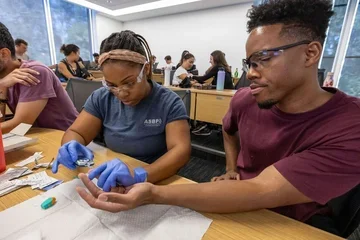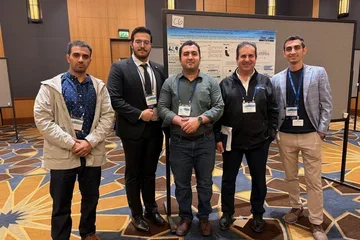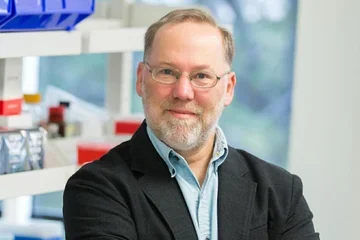Finding a way to halt memory loss

Dr. Itzhak Fried, UCLA Health’s director of Epilepsy Surgery, has received a $7 million grant to advance the study of electrical stimulation during sleep to improve memory.
For nearly three decades, Itzhak Fried, MD, PhD, has been at the intersection of two different but related paths: one as a neurosurgeon who has successfully treated thousands of patients with epilepsy, and the other as a neuroscientist, able to study — and answer — basic questions about the workings of the human brain.
It’s a combination that’s difficult to find, says Dr. Fried, director of Epilepsy Surgery in the Department of Neurosurgery at UCLA Health and professor of Neurosurgery and Psychiatry and Biobehavioral Sciences at the David Geffen School of Medicine at UCLA.
“You have people working in a clinical environment doing fantastic work, and there are scientists who are studying the brain under the lens of a microscope, but they don’t have contact with a real human brain,” says Dr. Fried, who also is co-director of the Seizure Disorder Center at UCLA Health.
Over the past decade, Dr. Fried and his team have been particularly interested in sleep and memory. His initial studies demonstrated what happens to human brain activity during sleep and what happens when a patient is sleep deprived. More recent studies have shown how the brain responds to electrical and auditory stimulation during sleep. His most recent paper, published in the July 2022 edition of Nature Neuroscience, explores insights gleaned during neurosurgery to record and stimulate single-neuron activity in people who can state their thoughts, memories and wishes.
“One of the major issues we are heavily invested in is that during sleep all the consolidation of memory is done,” Dr. Fried explains. “Essentially, all that you learn during the day eventually transfers to more stable memories during the night; this is a time where we can record brain activity and look at memories consolidated during sleep with the idea to be able to eventually enhance memory or intervene electrically or even with auditory stimulation alone.”
Dr. Fried and his team recently received a $7 million grant from the National Institute of Science to take the study to the next level.
“With this new grant, we’ll be able to collaborate with our electrical engineers and artificial intelligence people to try to analyze the signals the brain gives us and be able to develop closed-loop devices, or methods, to interact with the brain during sleep,” he says.
Ultimately, the goal is to be able to implant these closed-loop devices in patients with memory disorders, Dr. Fried says.
“There is what I call a cognitive tsunami coming to us,” he says. “Millions and millions of patients, the aging population, are going to have initially mild memory deficiencies and later develop Alzheimer’s and other disorders, and, presently, we really have no pharmacological treatment.”
Dr. Fried notes that the cognitive domain is perhaps the most difficult to tackle.
“We have patients starting to have mild cognitive impairment, they may be in the early stages of Alzheimer’s, and at this point, nothing can be done for these patients,” he says. “This is a big challenge. This is what we can offer — this kind of knowledge that is missing.”
Intractable seizure disorders and epilepsy
Dr. Fried has spent most of his career, since he started at UCLA in 1993, dedicated to the treatment of intractable seizure disorders and epilepsy. He has performed more than 1,000 surgeries on patients with epilepsy, with many patients now living seizure-free.
His research, which has resulted in more than 200 articles published in scientific journals, has led to groundbreaking discoveries of brain cells, some of which were previously discovered in animals but had never been seen in humans.
Dr. Fried also was the principal investigator of a seminal 2012 study on memory enhancement and deep-brain stimulation of the entorhinal area that was published in the New England Journal of Science, opening a new era in developing neuroprosthetic devices to help patients with memory disorders.
“We have spent years studying memory at the single neural level and have made some significant discoveries, and then we used that to develop methods to, essentially, electrically stimulate the brain in order to enhance memory,” he says. “We learn from our patients and at the same time we are able to apply what we’ve learned in an attempt to develop new ways of helping, not just that patient but also future patients; and not just epilepsy patients but patients with memory disorders and potentially other neurological afflictions.”
Under Dr. Fried’s direction, UCLA Health has become a leader in NeuroPace RNS System implants, with more than 100 performed since the device received approval from the U.S. Food and Drug Administration in 2013.
Similar to a pacemaker that monitors and responds to heart rhythms, the RNS system monitors and responds to brain activity to prevent seizures. It consists of a small, implantable neurostimulator connected to tiny wires placed in the seizure onset areas. The device detects seizure activity and responds by applying electrical pulses to stop the activity.
“Millions and millions of patients, the aging population, are going to have initially mild memory deficiencies and later develop Alzheimer’s and other disorders, and, presently, we really have no pharmacological treatment.” - Dr. Itzhak Fried
After RNS implantation, there is substantial reduction in seizures in many patients, in some cases a greater than 90% reduction, Dr. Fried says. One of those is a young woman on whom Dr. Fried performed awake-craniotomy language mapping, a state-of-the-art procedure in which the patient, while under general anesthesia, is awakened during surgery and tested for language performance using electrical stimulation.
In this case, the patient, a speech therapist, performed the tasks in three languages to ascertain whether removing areas of her brain causing her seizures would impair her multilingual abilities. The patient, while on the operating table, was able to tell her surgical team she wanted to proceed with the RNS implant rather than risk losing language functionality.
Individualized approach
Dr. Fried counts the late neurosurgeon Wilder Penfield, MD, among his early professional influences. Dr. Penfield was the first to use awake surgery to interact with patients and learn about the language of the brain and other basic functions. While a resident at Yale-New Haven Hospital, Dr. Fried also worked with patients during awake epilepsy surgeries, which gave him valuable insight into the inner workings of the brain, he says.
“One case when a patient stated, ‘I have an urge to move my hand,’ while electrical stimulation was applied to a specific brain region, an important insight was gained, later confirmed in other patients, about the role of that area, the supplementary motor area of the human brain, in the experience of will,” Dr. Fried says. “It was a wonderful example of providing clinical care to a patient while at the same time learning something fundamental about the human brain”
The treatment of epilepsy offers a variety of approaches, many of which were developed through research at UCLA, Dr. Fried notes.
“We started with ways we can remove, delicately, the epilepsy focus out of the brain, and then later adopted ablation of a focus using laser. With laser, we can reach deep targets in the brain and apply it locally, which is beneficial for treating highly localized epilepsies,” Dr. Fried explains. “In addition, we have disconnection procedures preventing spread of seizures as well as electrical stimulation that can be applied to several targets, so it’s an evolving field that requires finding out the right solution for the individual patient.”
Dr. Fried is fond of the motto “one patient at a time.”
“We don’t treat 500 patients that are the same person, over and over again. Especially when it comes to the brain, there is so much variability, such a huge spectrum. To me, to really treat the individual, we have to customize, sometimes even invent new tools and new approaches for each patient,” he says.
In treating each patient, Dr. Fried says, his goal is to learn something more about the human brain to help future patients.
“We’ve developed special techniques to help epilepsy patients and at the same time learn things about the brain that no other methods can achieve,” he says. “We are able to record from single cells in the human brain and learn a lot about the human mind, about memory, about perception, about action. And all these things can potentially be used to further develop therapeutic measures.”
Take the Next Step
Visit UCLA’s Department of Neurosurgery for more information.
Original Article: "Finding a way to halt memory loss"



